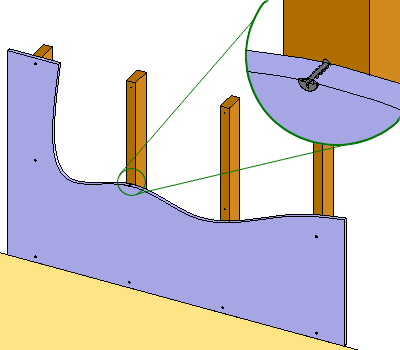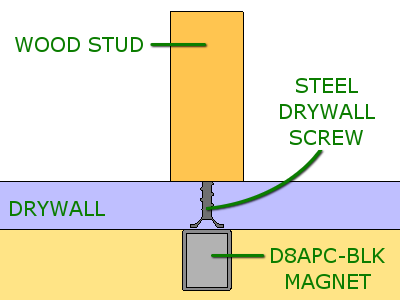How To Find A Stud With A Magnet
Finding Studs with Magnets 





Neodymium magnets tin aid you lot discover the studs hidden behind drywall.
Stud Finders:

Steel screws are commonly used to hold drywall to the wood studs hidden backside it.
In many habitation projects, finding the studs hidden behind drywall tin be a challenge. For a simple nonetheless amazingly constructive stud-finding solution, get a neodymium magnet. It can't detect the wood two-by-fours, but it hands locates steel screws that hold the drywall to the studs.
We often use a strong XLTK-BLU magnetic thumbtack for this job. It's a good size, easy to handle, and we usually have enough available. (There are ever a few stuck to our refrigerator doors.)
If yous slowly slide a magnet forth the surface of your wall, information technology volition be attracted to the steel drywall screws that come upwards very close to the surface of the drywall. Even better, yous can get out the magnet stuck to the screw to mark the stud throughout your project.
The plastic coated D8APC-BLK is probably our first selection for stud finding, since the smoothen plastic terminate won't mark the drywall. We've also used a simple D6C cylinder magnet, which is a handy addition to any toolbox.
If you're not using a Plastic Coated Magnet, embrace the magnet with a slice of record before sliding it all around your painted wall. Neodymium magnets are fabricated of metal which can make marks on the wall. The record prevents this and helps information technology slide around smoothly.
You tin also use bigger magnets for more than strength, of form.

A plastic coated magnet is attracted to the steel spiral that's just beneath the surface, making studs easy to locate.
Some Applied Advice:
Use magnets to aid locate the screws in the studs, but besides try to imagine the subconscious structure underneath. While magnets are ordinarily helpful, the process is easier if you look for some underlying clues. Many studs are spaced nigh 16 inches apart. Start your search from one edge of the wall, and piece of work xvi" from at that place. Electrical switches and outlets are ofttimes fastened to studs, so look for studs on either side of outlets.
Also look for imperfections in the drywall for hints nearly the locations of the screws. If the wall has settled over the years, these hints may be more obvious. Light the area well while working to highlight pocket-sized defects.
Once you find a stud using a magnet, hang a string from the magnet to help make the vertical line of the stud more obvious.
Sometimes magnets won't assist
What about if in that location are no screws? And then you're out of luck. A magnet can't "see" a woods stud. If the wall's structure uses only adhesive to hold the drywall to the studs, a magnet won't help at all.
What well-nigh plaster and lathe structure on older homes? While the rough wood construction might accept nails or tacks in it, they're ordinarily pretty far abroad from the surface of the plaster. Finding these tiny steel objects with a magnet is difficult at best.
What near steel studs?
Some studs are made of steel sheet-metal instead of wood two-by-fours. These studs are made of fairly sparse steel canvas, bent into a sturdy shape that resembles a two-by-iv in size.
Can you lot observe a steel drywall stud behind ½" or v/8" thick drywall? Yes, merely y'all demand a really powerful magnet. That XLTK-BLU or D8APC-BLK magnet isn't going to exert enough pull across that distance. You would need a bigger, more than powerful magnet similar a DCX0 or DEX2 cylinder magnet.
Of form, steel screws are commonly used to anchor drywall to the steel studs. You lot probably don't need such huge magnets, since finding the screws that are near the surface is still easier. Yous would only need those bigger magnets if the wall were synthetic using only adhesive to hold the wall to the studs, without screws.
The D8APC-BLK plastic coated magnet is our first choice for locating studs. This strong, durable and easily handled magnet is a great addition to any toolbox!
Source: https://www.kjmagnetics.com/blog.asp?p=stud-finder
Posted by: yockeybegry1954.blogspot.com


0 Response to "How To Find A Stud With A Magnet"
Post a Comment